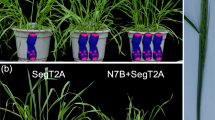Summary
-
1.
A survey has been made of chromosome numbers in natural populations ofDactylis. Diploids (2n=14), tetraploids (2n=28) and hexaploids (2n=42) have been found in our material, and B-chromosomes have been noted, particularly in diploid plants. In the F.A.O. collections accession numbers are given wherever interesting chromosome numbers have been found.
-
2.
Chromosome pairing has been studied in each of the chromosome number groups, and in diploid x diploid, and tetraploid x tetraploid hybrids. The gross similarity of the chromosome sets inDactylis has been demonstrated. Minor genetic and (or) chromosomal differences have been found between tetraploid populations.
-
3.
Chromosome pairing in the natural hexaploids is regular but variable.
-
4.
Interchange heterozygotes have been observed and analysed in the three chromosome groups.
-
5.
Chromosome breakage and reunion is frequent in plants derived from seed which has lost much of its germination capacity.
Similar content being viewed by others
References
Beddows, A. R. (1959). Biological Flora of the British Isles:Dactylis glomerata L.J. Ecol. 47: 223–239.
Borrill, M. (1961). Chromosomal status, gene exchange and evolution inDactylis. I. Gene exchange in diploids and tetraploids.Genetica 32: 94–117.
Borrill, M. &K. Jones, (1961). HexaploidDactylis.Nature (London) 190: 469–470.
Hanson, A. A. &H. D., Hill, (1953). The meotic behaviour of hexaploid orchard grass (Dactylis glomerata L.).Bull. Torrey bot. Club 80: 113–122.
Jones, K. (1956). Species differentiation inAgrostis. 1. Cytological relationships inA. canina L.J. Genetics 54: 370–376.
Jones, K. &M. Borrill (1962). Chromosomal status, gene exchange and evolution inDactylis. 3. The role of the inter-ploid hybrids.Genetica 32:296–322
McCollum, G. D. (1958). Comparative studies of chromosome pairing in natural and induced tetraploidDactylis.Chromosoma 9: 571–605.
Müntzing, A. (1937). The effects of chromosomal variation inDactylis.Hereditas, Lund 23, 113–235.
Myers, W. M. &H. Hill (1940). Studies of chromosomal association and behaviour and occurrence of aneuploidy in autotetraploid grass species, orchard grass, tall oat grass and crested wheat grass.Bot. Gaz. 102: 236–255.
Navashin, M. (1933). Origin of spontaneous mutations,Nature (London) 131: 436.
O'Mara, J. G. (1948). Acetic acid methods for chromosome studies at prophase and metaphase in meristems.Stain Tech. 23: 201–204.
Peto, F. H. (1933). The cytology of certain intergeneric hybrids betweenFestuca andLolium.J. Genet. 28: 113–156.
Riley, R., V. Chapman &G. Kimber (1959). Genetic control of chromosome pairing in intergeneric hybrids with wheat.Nature (London) 183: 1244–1246
Stebbins, G. L. &D. Zohary (1959). Cytogenetic and evolutionary studies in the genusDactylis. I. Morphology, distribution, and inter-relationship of the diploid subspecies.Univ. Calif. Publ. Bot. 31, 201: 1–40.
Symposium on Chromosome Breakage (1953). Suppl. toHeredity,6, pp. 315.
Tjio, J. &A. Levan (1950). The use of oxyquinoline in chromosome analysis.An. Estac. exp. Aula. Dei 2: 21–64.
Waite Agric. Res. Inst. (S. Aust.) (1956).Rep. 1954–55, p. 15.
Zohary, D. (1956).Cytogenetic studies in the polyploid complex of Dactylis glomerataL.-Ph.D. Thesis, Univ. of Calif. (unpublished).
Zohary, D. &I. Ashkenazi (1958). Different frequencies of supernumerary chromosomes in diploid populations ofDactylis glomerata in Israel.Nature (London) 182: 477–478.
Author information
Authors and Affiliations
Rights and permissions
About this article
Cite this article
Jones, K. Chromosomal status, gene exchange and evolution inDactylis . Genetica 32, 272–295 (1962). https://doi.org/10.1007/BF01816099
Received:
Issue Date:
DOI: https://doi.org/10.1007/BF01816099




